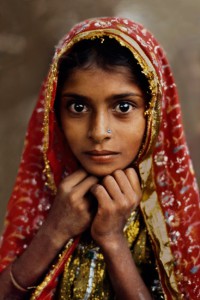The museum itself has a calming, private environment. Pictures are all set up within a reasonable distance from each other where your eyes are allowed to focus on one specific picture but also able to glance at one next to it. There are a large amount of portrait pictures and a few landscape images. There is roughly 20-25 different images. The photos were very vibrant in color and large in size and featured a look into the various lifestyles of India and northeastern Asian countries such as Tibet and the Himalayan region. The collection of photos were taken in the 1980s and a select few pieces in the early 2000s.
The photos showcases a lot of India’s common livelihood and religious life. There are pictures of Mosques, Muslims, the Holi Festival, regular people at work and architecture. We don’t see anything that isn’t pertaining to everyday Indian life. There aren’t any pictures of romantic nature, pictures focused solely on monuments or inanimate objects and there isn’t any pictures that are focused on royalty or lavish lifestyles. Steve McCurry’s approach to photographing India is very lively, he isn’t at a distance and shooting with a powerful lens, but rather he’s very much close to the action of the subject. His portraits are very intense as you can see the emotion in the subject’s eyes. His photos of the environment around him is taken in a way that uses diagonal angles and different ranges that puts the viewer in his position looking on at the area around him.
The photo that caught my attention is the “Nomad Girl” photo. I find the photo captivating because it captures mood and makes amazing use of colors. This photo fills the frame awesomely and also follows the dominant eye very well. Her vibrant red and gold headscarf frames her face well in the shot and brings attention to her facial features. The close up of the picture expresses her shy mood about having her picture taken as she is seen drawing her hands to her face as if she’s being extremely modest.
The “Afghan Girl” photo is a striking photo that completely almost looked like a modern day variation of the Mona Lisa. The photo has a great use of positioning and filling the frame. The lighting of the photo captures the intensity of her green entrancing eyes. The clarity of the picture and the enhanced features of her face also becomes sharp because the whole picture is made up of complimentary colors— such as the red hijab and her green eyes and the green background. The story of the girl— Sharbat Gul— was interesting. She was a refugee in a camp in Pakistan during the Soviet War, she was in her class and Steve McCurry decided to take her picture and thought nothing of it. When he took the photo he believed that this was the picture that would shape his career. This exhibit has shown me different ways that a photographer takes full advantage of their environment and it is amazing to see wha feelings a picture can invoke if it is taken in a certain way.




You point out at the beginning of your post that the exhibit is spacious. the pictures aren’t all on top of each other. Having room to view each one separately is a real luxury. Nomad Girl and Afghan Girl have strong similarities. It is the facial expression of the subject and her eyes that create an emotional reaction in us the viewers.